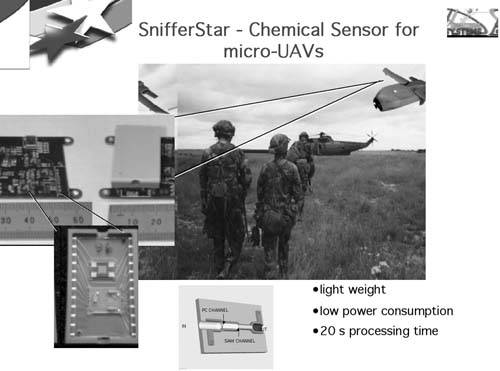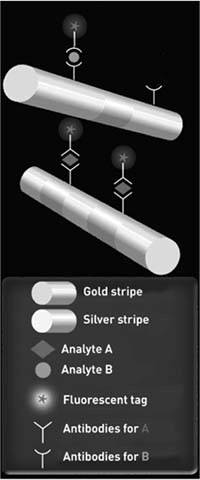Diverse Applications
| Although there are few sensors today based on pure nanoscience and it is early in the development of nano-enabled sensors, some of the possible devices and applications are already clear. Examples of nanotech and nano-enabled physical, chemical, and biological sensors are given in this section. Although sensors for physical quantities were the focus of early development efforts, nanotechnology will contribute heavily to realizing the potential of chemical and biosensors for safety, medical, and other purposes. Vo-Dinh, Cullum, and Stokes recently provided an overview of nanosensors and biochips for the detection of biomolecules.[12] It is anticipated that many major industries will benefit from nanotechnology-enabled sensors. Physical SensorsAn early example of a nanotech physical sensor is given in Figure 14-4. Researchers at the Georgia Institute of Technology demonstrated the world's smallest balance by taking advantage of the unique electrical and mechanical properties of carbon nanotubes.[13] They mounted a single particle on the end of a carbon nanotube and applied an electric charge to it. The carbon nanotube acted much like a strong, flexible spring. The nanotube oscillated without breaking, and the mass of the particle was calculated from changes in the resonance vibrational frequency with and without the particle. This approach may lead to a technique for the weight measurement of individual biomolecules. Figure 14-4. The mass of a carbon sphere shifts the resonance frequency of the carbon nanotube to which it is attached. (Courtesy of Walter de Heer, Georgia Institute of Technology, Atlanta, GA.) Cleland and Roukes at the California Institute of Technology reported the fabrication and characterization of a submicron, mechanical electrometer.[14] Shown in Figure 14-5, this device, made possible by modern nanofabrication technology, has demonstrated charge sensitivity less than a single electron charge per unit bandwidth (~0.1 electrons/sqrt (Hz) at 2.61MHz). This sensitivity exceeds that of state-of-the-art semiconductor devices. Figure 14-5. A nanometer-scale mechanical electrometer consists of a torsional mechanical resonator, a detection electrode, and a gate electrode used to couple charge to the mechanical element. (Reprinted with copyright permission from Nature Publishing Group.) Chemical SensorsA variety of nanotube-based gas sensors have been described in the past few years. Modi et al. have used carbon nanotubes to develop a miniaturized gas ionization detector.[15] This system could be used as a detector for gas chromatography. Titania nanotube hydrogen sensors have been employed in a wireless sensor network for detecting hydrogen concentrations in the atmosphere.[16] And Kong et al. have developed a chemical sensor for gaseous molecules, such as NO2 and NH3, based on nanotube molecular wires.[17] In a recent study, Parikh et al. used office equipment to print carbon nanotubes on flexible plastic to make sensors for organic vapors.[18] Sensors based on nanocantilevers also are possible. Datskos and Thundat have fabricated nanocantilevers using a focused ion beam (FIB) technique.[19] They developed an electron transfer transduction approach to measure the motion of the nanocantilever. An array of such sensors is shown in Figure 14-6. They may provide the sensitivity to detect single chemical and biological molecules. Structurally modified semiconducting nanobelts of ZnO have also been demonstrated to be applicable to nanocantilever sensor applications.[20][21] Figure 14-6. This array of chemical sensors incorporates MEMS cantilevers and the electronics for signal processing. (Courtesy of Thomas G. Thundat, Oak Ridge National Laboratory, Oak Ridge, TN.) BiosensorsNanotechnology will also enable the very selective, sensitive detection of a broad range of biomolecules. It is now possible to create cylindrical rods made up of metal sections that are between 50nm and 5 m m long. This is done by the sequential electrochemical reduction of the metal ions onto an alumina template. These particles, called Nanobarcodes, can be coated with analyte-specific entities, such as antibodies, for selective detection of complex molecules, as illustrated in Figure 14-7. DNA detection with these nanoscale coded particles has been demonstrated. Figure 14-7. Biomolecules can be detected optically when they are attached to antibodies affixed to particles called Nanobarcodes. Researchers at NASA Ames Research Center have taken a different approach to DNA detection.[22] Carbon nanotubes in the range of 3050nm in diameter are mounted vertically on a silicon chip, with millions of nanotubes covering the surface of the chip, as shown in Figure 14-8. Probe DNA molecules are attached to the ends of the nanotubes. When the chip is placed in a liquid containing DNA molecules, the substrate DNA attaches to the target DNA, increasing the measured electrical conductivity. This approach, expected to reach the sensitivity of fluorescence-based detection systems, may find application as a portable sensor. Figure 14-8. Vertical carbon nanotubes are embedded in a silicon chip. DNA molecules attached at the ends of the nanotubes detect specific types of DNA or other substances. (Courtesy of NASA Ames Research Center, Moffett Field, CA.) Deployable SensorsWe are starting to see nanoscale materials and devices being integrated into real-world systems. An example is SnifferSTAR, a lightweight and portable chemical detection system, shown in Figure 14-9.[23] This unique system combines a nanomaterial for sample collection and concentration with a MEMS-based chemical lab-on-a-chip detector. SnifferSTAR has defense and home-land security applications and is ideal for deployment on unmanned systems such as micro-UAVs (unmanned aerial vehicles). Figure 14-9. A nano-enabled chemical sensor has been integrated into a micro-UAV. (Courtesy of Sandia National Laboratories, Albuquerque, NM, and Lockheed Martin Corporation.) Other areas expected to benefit from sensors based on nanotechnologies include the following: transportation (land, sea, air, and space); communications (wired and wireless, optical and radio frequency); buildings and facilities (homes, offices, factories, and other structures); monitoring of humans (especially health and medical monitoring of aging baby boomers); and robotics of all types. The integration of nano-enabled sensors into commercial and military products will be fueled by many new companies making nanomaterials and some making sensors based on them. Although much progress is being made, many challenges still must be met before we will see the full impact of nanotechnology in the sensor industry. They include reducing the cost of materials and devices, improving reliability, and the packaging of the devices into useful products. Such challenges notwithstanding, the future of nano-enabled sensors is bright for several reasons. It may be possible to put sensors into very small volumes, including individual cells. Nanosensors may have a significant scientific impact by measuring molecular interactions and kinetics on very small scales at high speeds. The practical impacts of nanosensors will include having many sensors in a single system to improve both the range of materials that can be analyzed and the lifetime of the overall system. In short, nanotechnology presents a historic opportunity for the improvement of existing sensors, as well as the development of new sensors that will have numerous new applications in many industries.
|
EAN: 2147483647
Pages: 204



